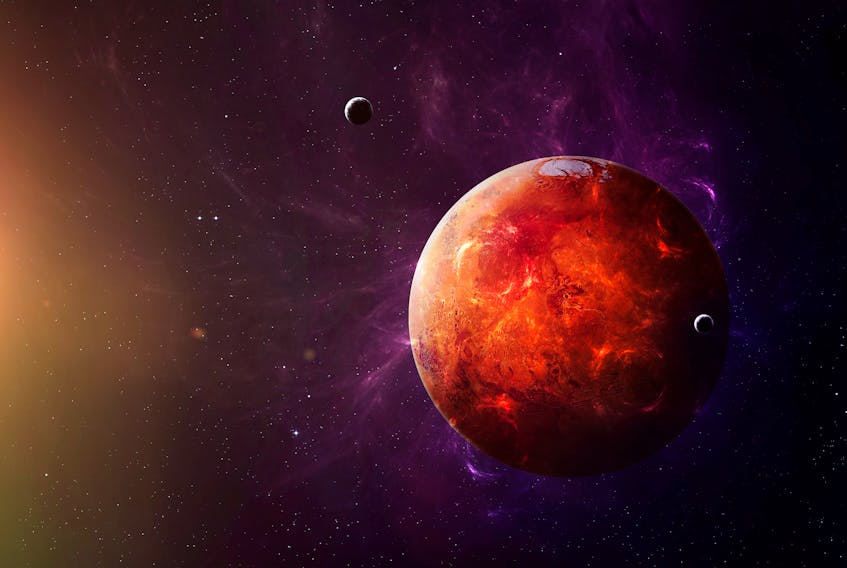No other planet has inspired more speculation as to its past and future suitability for life than Mars. Fourth planet from the Sun, Mars is one of the five “bright”, naked-eye planets visible in the night sky. Named after the Roman god of war, and often referred to as the Red Planet (primarily due to its distinctive blood-red colour from the iron oxide in its soil), Mars was known to ancient peoples by various names. To the ancient Sumerians, it was “Nergal” — god of war and plague. The ancient Greeks named it “Ares”, their god of war. Egyptians referred to it as “Her Desher” meaning “the red one”. Eastern Asian cultures called it “the fire star.”

At an average distance of 227,936,640 km, from the Sun, Mars has a highly eccentric elliptical orbit. Mars is closest to Earth every 26 months. Its closest approach (55,758,000 kms) to Earth (in nearly 60,000 years) came in August 2013; it then shone at mag. -2.9. Prior to that, its closest approach was in September 57,617 BC. The next closest approach will be in 2,287.
Mars has two moons — Phobos (meaning panic and fear) and Deimos (meaning terror and dread), mythical Greek twins who followed their father, Ares, into battle. It has the largest volcano (600 kms diameter) and the highest-known mountain, Mons Olympus (27 kms high), as well as the largest canyon, Valles Marineris (up to10 km. deep, 600 kms wide, and 4,000 kms long) in our solar system. A Martian year is equivalent to 687 Earth days.
Its movement has been studied since ancient times. Ptolemy, a Roman astronomer, mathematician and geographer, studied Mars’ movements and included his calculations in his famous book “Almagest,” which was used as the basis for western astronomy for the next 14 centuries.
Mars has two moons — Phobos (meaning panic and fear) and Deimos (meaning terror and dread), mythical Greek twins who followed their father, Ares, into battle.
Galileo was the first astronomer to view Mars through a telescope in 1610. In 1877, Italian astronomer, Giovanny Schiapelli used his 8.7-inch telescope to produce the first detailed map of Mars. He claimed to have observed numerous “canali” (channels or grooves) on the planet’s surface. These canali proved to be nothing more than an optical illusion by later observations with more powerful telescopes. Nonetheless, the purported discovery of canali gave rise to the public’s fascination with possible life on the planet’s surface. If these canals existed, then, surely, they must have been made by an intelligent civilization of Martians to carry water across the planet’s surface, presumably to their towns and cities. The astronomer Percival Lowell observed Mars in his large telescope in 1894 and confirmed the existence of what he believed to be straight canals crossing the surface, as well as vast seas and large areas of vegetation. His books on Mars greatly inflamed the public’s imagination regarding a possible Martian civilization. Many prominent writers added to this Mars civilization mania, among them H.G. Wells (“The War of the Worlds”, 1898); Edgar Rice Burroughs (Barsoom series, 1912); C.S. Lewis (“Out of the Silent Planet”, 1938); and Ray Bradbury (“The Martian Chronicles”, 1950..
The public’s fascination with Mars continued into the birth of the space age in the mid-1960s. Dozens of robotic missions to Mars have taken place by a number of countries beginning with America’s Mariner missions in the ’60s and ’70s. These were followed by a slew of missions, from the Viking landers in the mid ’70s to NASA’s Insight lander in 2018. All these missions were to assess its suitability for potential human habitation at some point in the future.
So, will humans ever live on the Red Planet? Mars has a very thin atmosphere, composed primarily of carbon dioxide (95.3 per cent), nitrogen (2.7 per cent), argon (1.6 per cent), oxygen (0.13 per cent), carbon monoxide (0.08 per cent) and other trace gases. Humans would need to terraform the planet’s surface to make it viable for plant life (trees and crops), the primary producers of larger quantities of atmospheric oxygen. Despite recent evidence that Mars at one time likely water on its surface and underground, what water it now is in the form of ice in the north and south polar caps. Humans would need to adjust to Mars’ low atmospheric pressure (<1 per cent of Earth) and moderate gravity. Plus, it would take approximately one year for any manned mission to reach Mars, a voyage complicated by the extreme radiation of outer space, and the impact of micro-gravity on the travellers’ physiology. Despite such obstacles, manned missions to Mars are expected to begin later in this century or early in the next. It is not likely that humans will live on Mars until well into the 22nd century. Who knows, perhaps your great-great grandchildren may, one day, travel to Mars for a holiday.
Mars, along with Venus and Mercury, will be visible in the night sky later this month. Jupiter and Saturn are still visible at dusk in the SW sky.
The Orionid meteor shower (radiant in Orion - the Hunter) peaks on the night/morning of October 21/22. These bright meteors are debris from the famous Comet Halley; expect to see about 20+/hr (though possibly more) from a dark site away from city lights.
Until next time, clear skies. Next week, Jupiter - mightiest of the planets.
Glenn K. Roberts lives in Stratford, P.E.I., and has been an avid amateur astronomer since he was a small child. His column, Atlantic Skies, appears each week. He welcomes comments from readers, and anyone who would like to do so is encouraged to email him at [email protected].
Events:
Oct. 21 - last Quarter Moon
21/22 - Orionid meteor shower peaks
26 - Moon at perigee (closest to Earth)









